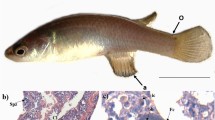Abstract
The cyprid larvae ofScalpellum scalpellum (L.), a hermaphroditic goose barnacle with dwarf males, are morphologically alike and no characters distinguish the sexes. To elucidate the controversy over the relative significance of genetic and environmental factors in the sex determination of this species, laboratory experiments were performed involving the introduction of cyprid larvae of different parental origin to different densities of adult hermaphrodites without dwarf males. Cyprids introduced to adult hermaphrodites metamorphosed to either dwarf males or hermaphrodites significantly different from the controls without adult hermaphrodites. The proportion which metamorphosed into dwarf males increased with increasing adult density. Not more than 51% metamorphosis to dwarf males could be obtained, indicating a genetic component in the sex differentiation. It was concluded that all cyprids are potential hermaphrodites, but that about 50% possess the capability of metamorphosing into dwarf males as well, if adult hermaphrodites with free receptacles are available. Consequently, both genetically and environmentally controlled components influence sex determination in this species.
Similar content being viewed by others
Literature cited
Callan, H. G.: Determination of sex inScalpellum. Nature, Lond.148, 258 (1941)
Darwin, C.: A monograph on the subclass Cirripedia 1. The Lepadidae or Pedunculated Cirripeds, 400 pp. London: Ray Soc. 1851
Gomez, E.: Sex determination inBalanus (Conopea) galeatus (L.) (Cirripedia Thoracica). Crustaceana28, 105–107 (1975)
Gruvel, A.: Etude du male complémentaire du ‘Scalpellum vulgare’. Arch. Biol. Belges16, 27–47 (1899)
Gruvel, A.: Monographie des Cirrihpédes, 427 pp. Paris: Masson et Cie 1905
Kaufmann, R.: Zur Embryonal- und Larvalentwicklung vonScalpellum scalpellum L. (Crust. Cirr.) mit einem Beitrag zur Autökologie dieser Art. Z. Morph. Ökol. Tiere55, 161–232 (1965)
Krüger, P.: Studien an Cirripedien. Z. indukt. Abstamm.- u. Vererb.-L.24, 105–158 (1921)
Sokal, R. R. and F. J. Rohlf: Biometry. The principles and practice of statistics in biological research, 2nd ed., 859 pp. San Francisco: W. H. Freeman & Co. 1981
Svennevig, N.: Bidrag til biologien afScalpellum scalpellum (L.) en pedunculat cirriped (langhals) med både hermafroditer og dværghanner (komplementærhanner) Cand. scient. thesis, University of Copenhagen, 107 pp. 1978
Veillet, A.: Sur la métamorphose et le determinisme du sexe du cirripedeScalpellum scalpellum Leach. C. r. hebd. Séanc. Acad. Sci. Paris.253, 3087–3088 (1961)
White, F.: The chromosomes ofTrypetesa lampas (Cirripedia, Acrothoracica). Mar. Biol.5, 29–34 (1970)
Author information
Authors and Affiliations
Additional information
Communicated by T. Fenchel, Aarhus
Rights and permissions
About this article
Cite this article
Svane, I. Sex determination inScalpellum scalpellum (Cirripedia: Thoracica: Lepadomorpha), a hermaphroditic goose barnacle with dwarf males. Mar. Biol. 90, 249–253 (1986). https://doi.org/10.1007/BF00569135
Accepted:
Issue Date:
DOI: https://doi.org/10.1007/BF00569135




